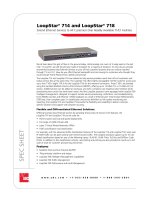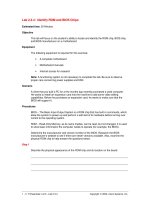Tài liệu Mapping Tables and Columns docx
Bạn đang xem bản rút gọn của tài liệu. Xem và tải ngay bản đầy đủ của tài liệu tại đây (16.52 KB, 4 trang )
Mapping Tables and Columns
In Chapter 3
, "Introduction to Structured Query Language (SQL)," you learned that the
AS keyword is used to specify an alias for a table or column. The following example uses
the AS keyword to alias the CustomerID column as MyCustomer and also alias the
Customers table as Cust:
SELECT CustomerID AS MyCustomer, CompanyName, Address
FROM Customers AS Cust
WHERE CustomerID = 'ALFKI';
Figure 10.2
shows the results of this SELECT statement.
Figure 10.2: Using the AS keyword
The following code uses this SELECT statement to populate a DataSet object named
myDataSet:
SqlCommand mySqlCommand = mySqlConnection.CreateCommand();
mySqlCommand.CommandText =
"SELECT CustomerID AS MyCustomer, CompanyName, Address " +
"FROM Customers AS Cust " +
"WHERE CustomerID = 'ALFKI'";
SqlDataAdapter mySqlDataAdapter = new SqlDataAdapter();
mySqlDataAdapter.SelectCommand = mySqlCommand;
DataSet myDataSet = new DataSet();
mySqlConnection.Open();
mySqlDataAdapter.Fill(myDataSet, "Customers");
mySqlConnection.Close();
Notice the Fill() method specifies the name of the DataTable as Customers, which is
known as the source DataTable name.
To map a DataTable in your DataSet, you create an object of the DataTableMapping
class using the Add() method; this class belongs to the System.Data.Common namespace,
which you should import into your program. The following example creates a
DataTableMapping object named myDataTableMapping, passing Customers and Cust to
the Add() method:
DataTableMapping myDataTableMapping =
mySqlDataAdapter.TableMappings.Add("Customers", "Cust");
Notice that the Add() method is called through the TableMappings property. The
TableMappings property returns an object of the TableMappingCollection class. This
object is a collection of TableMapping objects, and you use a TableMapping object to
map the source name to a different DataTable name, therefore, the previous example
maps the source name of Customers to Cust.
You can read this mapping using the SourceTable and DataSetTable properties of
myDataTableMapping. For example:
Console.WriteLine("myDataTableMapping.SourceTable = " +
myDataTableMapping.SourceTable);
Console.WriteLine("myDataTableMapping.DataSetTable = " +
myDataTableMapping.DataSetTable);
This example displays the following:
myDataTableMapping.DataSetTable = Cust
myDataTableMapping.SourceTable = Customers
You should also change the TableName property of the DataTable object in your DataSet
to keep the names consistent:
myDataSet.Tables["Customers"].TableName = "Cust";
Tip It is important that you change the TableName since it will otherwise keep the
original name of Customers, which is a little confusing when you've already specified
the mapping from Customers to Cust earlier.
Next, to alias the CustomerID column as MyCustomer, you call the Add() method
through the ColumnMappings property of myDataTableMapping:
myDataTableMapping.ColumnMappings.Add("CustomerID", "MyCustomer");
The ColumnMappings property returns an object of the DataColumnMappingCollection
class. This object is a collection of DataColumnMapping objects. You use a
DataColumnMapping object to map a column name from the database to a different
DataColumn name, therefore, the previous example maps the CustomerID column name
from the database to the DataColumn name MyCustomer.
Listing 10.13
illustrates how to map table and column names using the code shown in this
section.
Listing 10.13: MAPPINGS.CS
/*
Mappings.cs illustrates how to map table and column names
*/
using System;
using System.Data;
using System.Data.SqlClient;
using System.Data.Common;
class Mappings
{
public static void Main()
{
SqlConnection mySqlConnection =
new SqlConnection(
"server=localhost;database=Northwind;uid=sa;pwd=sa"
);
SqlCommand mySqlCommand = mySqlConnection.CreateCommand();
mySqlCommand.CommandText =
"SELECT CustomerID AS MyCustomer, CompanyName, Address " +
"FROM Customers AS Cust " +
"WHERE CustomerID = 'ALFKI'";
SqlDataAdapter mySqlDataAdapter = new SqlDataAdapter();
mySqlDataAdapter.SelectCommand = mySqlCommand;
DataSet myDataSet = new DataSet();
mySqlConnection.Open();
mySqlDataAdapter.Fill(myDataSet, "Customers");
mySqlConnection.Close();
// create a DataTableMapping object
DataTableMapping myDataTableMapping =
mySqlDataAdapter.TableMappings.Add("Customers", "Cust");
// change the TableName property of the DataTable object
myDataSet.Tables["Customers"].TableName = "Cust";
// display the DataSetTable and SourceTable properties
Console.WriteLine("myDataTableMapping.DataSetTable = " +
myDataTableMapping.DataSetTable);
Console.WriteLine("myDataTableMapping.SourceTable = " +
myDataTableMapping.SourceTable);
// map the CustomerID column to MyCustomer
myDataTableMapping.ColumnMappings.Add("CustomerID", "MyCustomer");
DataTable myDataTable = myDataSet.Tables["Cust"];
foreach (DataRow myDataRow in myDataTable.Rows)
{
Console.WriteLine("CustomerID = " + myDataRow["MyCustomer"]);
Console.WriteLine("CompanyName = " + myDataRow["CompanyName"]);
Console.WriteLine("Address = " + myDataRow["Address"]);
}
}
}
The output from this program is as follows:
myDataTableMapping.DataSetTable = Cust
myDataTableMapping.SourceTable = Customers
CustomerID = ALFKI
CompanyName = Alfreds Futterkiste
Address = Obere Str. 57









